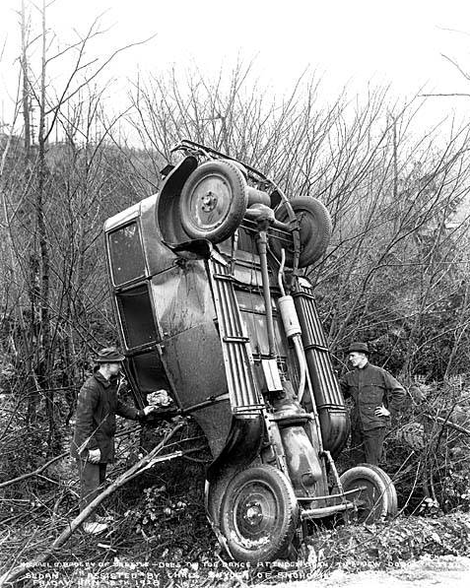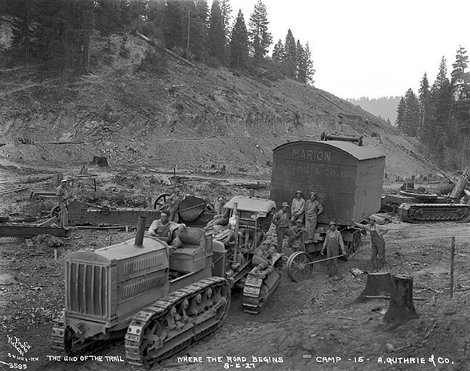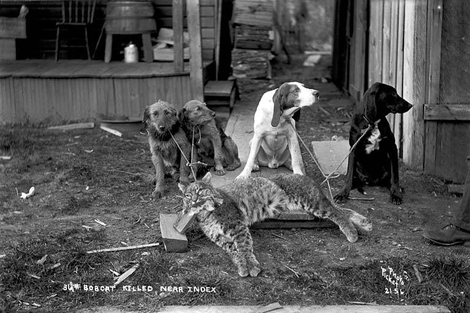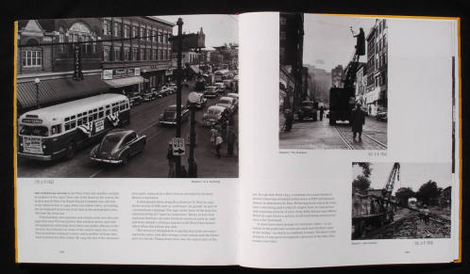
Automobile accident at Index, January 13, 1928

A. Guthrie and Co. equipment, August 5, 1927
I can usually stand but so much reading and writing about gear. After too much of it, the time comes when I have to go take refuge in pictures again. Nothing's quite as bracing as a good historical archive, looking at the work of photographers who often had only one shot to work with and generally had no artistic pretensions because photography—their photography, certainly—wasn't considered art. They often simply photographed things they found interesting, meaningful, unusual, or remarkable.
The University of Washington Libraries Digital Initiatives program has a large selection online from its archives of the work of Lee Pickett, a photographer who worked in Washington State from 1911 until the 1940s. The official photographer of the Great Northern Railway, he was based in Index, Washington, in the heart of the Cascade Mountains.
The writing of titles and notes directly on the negatives is often a tip-off to a working photographer's lack of artistic pretense; it's almost a formal flag of the primacy of the documentary record. (Although photographers got good at writing backwards, they sometimes still slanted their letters forward as they wrote, making the slant look backwards in the print.)
Note the crude but effective posing aids in the picture below (that's one way to make dogs sit still for a picture!). Two of the dogs are looking intently at the man whose foot appears in the right side of the frame. A beautiful photograph, of which any postmodernist could be proud.

Bobcat killed near Index, no date.
________________________________
Mike
Featured Comment by John Roberts: "'They often simply photographed things they found interesting, meaningful, unusual, or remarkable.' I find this approach to photography many times produces work that is so much more interesting than what is usually offered up as 'art' photography. Perhaps it's the complete lack of pretense that allows photographers like Mr. Pickett to produce photographs that still hold our interest so many decades later."
Featured Comment by John Robison: "When I view photos like these, of a long gone time, I have a question. Who are taking pictures today of the usual, the boring, the record, the mundane, the ebb and flow of "common" things. Photos that will wind up in the main street museums of towns small and large? Seeing these makes me want to grab the largest format camera I have, load it with some 100 iso film, and go make pictures of these very common things."
Mike replies: I've always said that at the very least, cities and states should have official "public photographers" whose job it is to document everyday life, what the city looks like at any given time, simply to leave some tracks and make a record. If it were something that we had started doing a hundred years ago, no one would question it. But since we don't do it, no one sees the point in it. It would amount to the most minuscule drop in the bucket of public expenses, but it would likely provide a meaningful adjunct to the motley of pictures that are taken (and that endure) haphazardly, by artists, amateurs, snapshooters, photojournalists, and for commercial purposes. To answer your question, though, probably the closest thing to what you're talking about are newspaper photographers. Of course, one problem with that is that when newspapers go out of business, often as not their archives are discarded.
Featured Comment by John Camp: "Actually, the place where this gets done, a lot, is not museums but state historical societies. They often buy large collections of genre photos, absorb old newspaper files, and so on. These society files, along with newspaper files, regularly get used to create "Our Town Yesterday" books, which you can find everywhere. I even wrote the introduction to one, called Strange Days, Dangerous Nights, by Larry Millet.

Strange Days, Dangerous Nights
"For people who live near a state capital, the historical societies are photographic treasure-houses, as are (sometimes, depending on the funding mechanism) local county and city historical societies. A pretty famous photo book, Wisconsin Death Trip, came mostly through one of these societies, I think (from Jackson County, Wisconsin).
"While these societies are a wonderful resource for daily photography, one problem is that the photos tend to be 'event' oriented. I think there might be some value to organizing a kind of photo expedition which would simply take 'flat' photos—the interiors of supermarkets and stores and factories, document dress and 'what's in the refrigerator' and medicine cabinets, including close-ups of the contents of medicines and cereals and all the other things we put in our mouths...a kind of uninflected index of our civilization at this point."
Mike adds: Wisconsin Death Trip is a great book, although it's one I've never owned (I thoroughly osmosed the library's copy in art school).



I know Photoshop when I see it. ;~)
Posted by: Christopher Lane | Saturday, 27 September 2008 at 01:05 PM
Wow. I look at those photos and for some reason, along with booze and tobacco, I see danger everywhere.
Precarious situations abound in those photos.
Even on the baseball fields..fielding a grounder looks like a trip to the dentist or the nosebone doctor.
Very cool stuff.
Posted by: David | Saturday, 27 September 2008 at 01:23 PM
"They often simply photographed things they found interesting, meaningful, unusual, or remarkable."
That is of course what people disparagingly call "snapshots" when they're taken today. And without a doubt, a lot of situational photography was very bad then as now. But it seems we have inbuilt cultural filters that winnows out all the boring, bad or uninteresting creations over time and leaves us remembering and treasurign just the small portion that really did turn out to be good.
Same thing happens with music. Go no further than the 1970's, where truly horrible pop music was put out by the shovelload every year. But all that we remember now from that time is the few pearls of truly good music.
Posted by: Janne | Saturday, 27 September 2008 at 09:09 PM
I'd like to comment on the featured comment by John Roberts.
John, if you think 'art photography' comes from the photographers pretention you haven't seen much yet. May I suggest you take a look at the work of -for example- Mario Giacomelli? Then come back a tell us again that these photographs do not hold our interest many decades later?
Posted by: cb | Sunday, 28 September 2008 at 03:23 AM
At last an appreciation of vernacular photography.
The curators of this show and book devoted themselves to a treasure trove of mostly LF negs taken by New South Wales wallopers (cops to you) for evidentiary purposes.
Just in case you thought that drag queens and cocaine were baby boomer phenomena.
Highly recommended!
http://www.arts.usyd.edu.au/publications/philament/issue10_pdfs/ALLEN_CityOfShadows.pdf
http://www.shop.nsw.gov.au/pubdetails.jsp?publication=5866
regards - Ross
Posted by: Ross Chambers | Sunday, 28 September 2008 at 04:15 AM
It's certainly true that thinking only of the subject has made a lot of nice photographs over the years.
But if we go so far, as some people do, as to claim that deciding *what* to photograph is the most important thing for the photographer, then I get a bit lost. If that's true, then a nice automatic camera is all we need, and photographs hold little interest beyond the subject.
André Kertész didn't seem to worry much about *what* he photographed, he just used whatever turned up which might be used to make an interesting picture.
Posted by: Eolake Stobblehouse | Sunday, 28 September 2008 at 10:45 AM
Yeah you'd need to be mad to photo ordinary life. Especially when you get no encouragement from local arts.
I asked our local Museum if they were interested and yes they were. They asked me to leave my work in my will to them! However for the moment they had absolutely no money and when I asked where would they get an in depth photographic record to cover aspects of ordinary life. Their answer was that when they want them (photos) they'll do as before scavange i.e. tackling it now in an organised fashion was not even up for debate.
I pointed out that most of their collections were from postcard companies (or pictorial essays for magazines), these no longer exist. I just got blank looks.
Then 6 months later there was the announcement of £12 million ($24million) being spent on the main building interior (not exhibits just the building). I just thought it was a bit out of balance.
Perversely when I do manage to scrape money together the general public like the photos, just not the gov. types with money. Rant over.
Sample stuff in my url above. Sorry Mike its in Flickr.
Recently I've put a lot more effort into films about ordinary people and life.
Posted by: Louis McCullagh | Sunday, 28 September 2008 at 01:36 PM
Mike -
In response to your comment about municipalities paying a photographer to document the everyday happenings of their area, I think that you're absolutely right. The only thing I'd add is that now -- brace yourself for a cliche buzzword -- in the digital age, photographs of the everyday and the mundane are absolutely pervasive. That's not to say they're necessarily good, so your idea is still totally valid, but I think an even more valuable endeavor is to devise ways to automate the organization of the massive amount of photography that's available online. As a computer scientist (and technophile!) by profession I'm certainly biased, but it seems to me that having the ability to ask questions like "What did the Light and Pratt St intersection in Baltimore look like at night in September of 2008?" or "Show me pictures of people from mid-sized cities on the Eastern seaboard of the United States in cold weather in 2008" (or whatever) and have a computer bring up a series of images taken there, under those conditions, at around that time period would be unbelievably valuable in the future. We have primitive versions of this right now, almost always hand-organized by a human being, but an infrastructure and intelligence that made something like this easy is better (and more sophisticated). It's totally possible and (lots of) smart people are working on this kind of thing - just a matter of time.
Can't wait to be able to search for "Blog posts on TOP post- RSS-feed-debacle featuring historical black and white photos from turn of the century America." ;-)
Dave
http://www.seinberg.net
Posted by: Seinberg | Sunday, 28 September 2008 at 09:23 PM
One good idea for getting this kind of everyday record would be simply to have city hall, a local museum or similar sponsor a "year in review"-style yearly photo competition. The emphasis would be on daily life as much as notable local events, and the selected images (or heck, all submissions) would be kept by the museum or city hall and used for retrospectives, illustrations, exhibiting change over time and so on.
That wouldn't even cost as much as paying one single photographer; mostly a part-time job organizing it for a few weeks every year, some small funds for a winning award of some kind (donated photography stuff from local business?) and the use of whatever public space is available in the town or city.
For this kind of everyday photography I think there is greater value in having a multitude of different photographers each with their own perspective, rather than have one "official" person that is necessarily limited to what he or she finds important and interesting.
Posted by: Janne | Sunday, 28 September 2008 at 09:36 PM
I'm not sure how it could be achieved, but archives of quotidian life are so important.
Some time ago I cut a TV film about the life of a woman whose salad days were in Melbourne in the very early days of the 20th century. It was extremely difficult to find motion picture material or stills that had any relationship to her memories of everyday life of the time. Stuffed shirts and politicians were easy to find, ordinary folk about their daily lives, almost impossible.
The Australian National Film and Sound Archive ran a programme a few years ago encouraging people to look under their beds and in their sheds for those pictures that grandad spent his time fooling about with. They found and preserved many treasures.
I gave our local studies librarian negs and prints of street scenes of a township up the line that will be extensively redeveloped soon, most of it demolished. It's about all you can do when the developers can't be stopped, and it's one way to help.
Regards - Ross
Posted by: Ross Chambers | Monday, 29 September 2008 at 04:01 AM